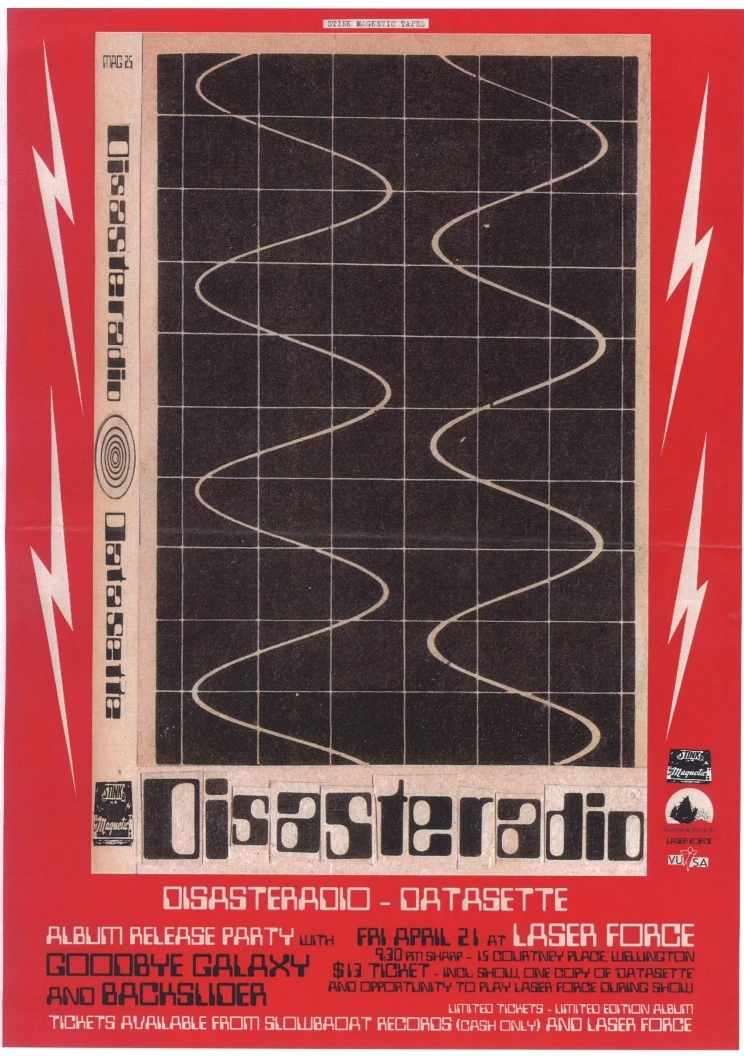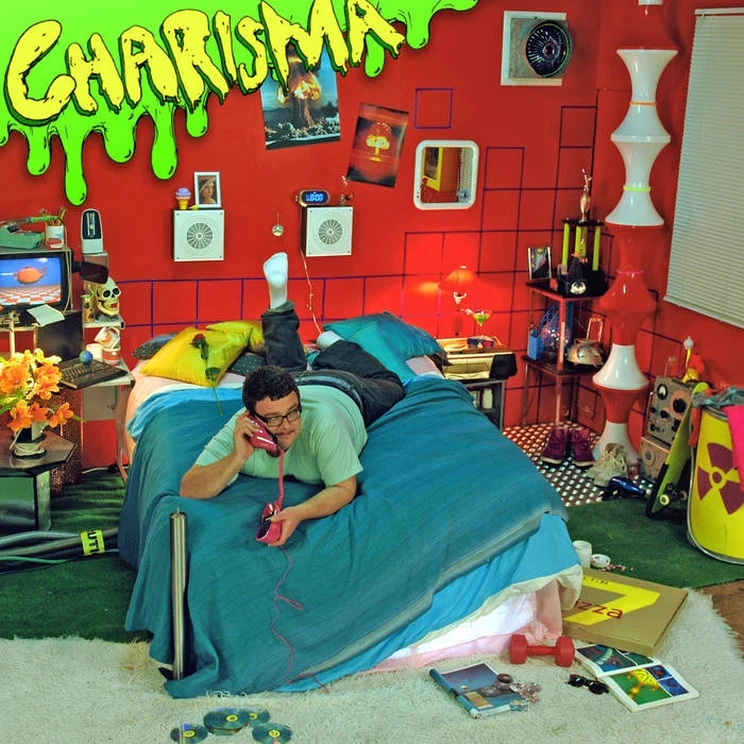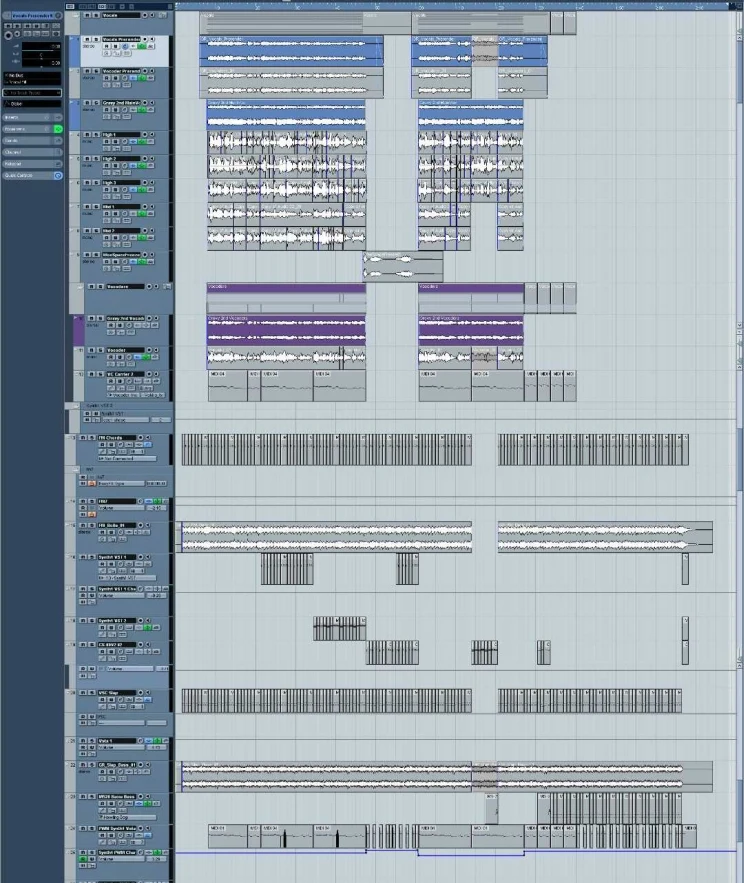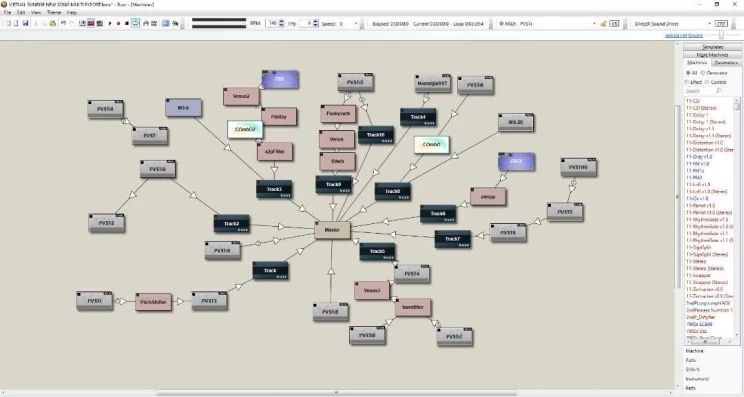The Disasteradio Project
Making more music available for download and reuse from the Luke Rowell Collection, one of New Zealand's foremost computer musicians who records and performs as Eyeliner or Disasteradio.
The Luke Rowell Digital Music Collection
During NZ Music Month 2021, we launched the Luke Rowell Digital Music Collection forth into the world. This open-access collection represents the Turnbull Library’s first foray into archiving contemporary productions created on Digital Audio Workstation (DAW) software.

Performance by Disasteradio at San Francisco Bath House, Wellington (2015). Photo by Wendy Collings. Ref: PADL-001487. Alexander Turnbull Library.
We kicked things off with an archive for the album Buy Now (2015) issued under one of Rowell’s aliases, Eyeliner. Much of this archive can be freely downloaded and reused under a Creative Commons licence. To provide some inspiration, we also invited musicians from around the world to contribute to a Bandcamp remix album Free Buy Now Remixes, also released in May 2021.
As our accompanying blog outlined, archiving DAW productions in their native form is a technically daunting task. Yet, as most music releases are now produced on such software, a way must be found! The project to archive Luke Rowell’s music – what we call the Disasteradio Project – was an opportunity to develop sustainable approaches.
The latest news is that we’ve now finished archiving material from Rowell’s 2010 album Charisma. This is also open-access and downloadable for your listening, research and reuse pleasure.
Watch Luke talk about Disasteradio's 'Charisma'
Embedded content: https://www.youtube.com/watch?v=8TgHmmYh554Luke talks about Disasteradio's 'Charisma' — transcript
Speaker
Luke Rowell
Hey, it's me
And now we're out in the country.
In the sunny Canterbury Plains
Aotearoa New Zealand
With another special announcement.
Last year with National Libraries New Zealand
We released an archive project
for Eyeliner's Buy Now.
Now we're back at it again
for Disasteradio's 2010 album Charisma
Produced with the National Library's team
And music curator Michael Brown
We have for you
Stems with effects
Horses
MIDI
Hot Compost
Screencasts featuring the
production techniques
And ideas behind
all the songs.
Cool dogs including Ralph.
Stems, without effects.
Herbs including Coriander
or Cilantro
Spreadsheets and screenshots
detailing all the recording sessions.
Once again released under
Creative Commons license
Attribution - Noncommercial - Sharealike.
Yup, this includes everybody's favourite
Gravy Rainbow.
Enjoy Disasteradio's Charisma
with National Libraries New Zealand.
As part of the Luke Rowell music collection.
And find all the links below, cheers!
Synthesizer pop music since Y2K
Born in 1983 and raised in Lower Hutt, Luke Rowell is one of New Zealand’s foremost synthpop musicians. As Martyn Pepperell writes in a two-part feature on Audioculture, Rowell “grew up in a family with interests that met at the intersection of art and technology.”
Rowell had an ear tuned to electronic and computer-based sounds from a young age. Early musical inspirations include pioneering synthesizer musician Wendy Carlos (Switched on Bach) and the group Hot Butter, best known for their 1972 synth instrumental ‘Popcorn’. 8-bit video game soundtracks also made a strong impression. By the late 1990s, Rowell was involved in the Wellington music underground, where the real-world scene of self-publishing, zines, and punk gigs was beginning to overlap with the bulletin boards and file-sharing sites of the early internet.

Poster for Disasteradio, Datasette (2006). Luke Rowell Collection.
Luke Rowell’s first albums were CD-Rs released as Disasteradio, an alias taken from a Cold War-era radio packaged in a mushroom-cloud emblazoned box. The pulsing electronic beats and pop-culture smarts of these recordings caught the attention of Wellington promoter and manager Ian Jorgensen, who went on to feature Disasteradio in national group tours in the mid-2000s.
Jorgensen’s record label, A Low Hum, also released Rowell’s breakthrough: Visions (2007). The album received glowing reviews in the local press, Aaron Hawkins of Critic magazine declaring the album “the sound of a veteran knob-twiddler and circuit bender making a damn good party album.” Real Groove magazine voted Visions their 2007 Album of the Year.

Disasteradio, Charisma (2010).
The Sound of ‘Charisma’
Next up for Disasteradio was Charisma (2010). Displaying a similar dayglo vibe to previous works, the album achieved a new level of musical craft. As Michael Harvey’s review in Under the Radar noted, “The attention to the layers of sonic detail that Rowell has lavished on this album is remarkable and is what makes it transcend the frivolity of music made for ‘da club’.”
Charisma’s technical sophistication was complemented by futuristic song themes, including techno-psychosis in ‘Computer Whiz’ and post-human romance in ‘No Pulse’, and a feast of infectious hooks. The album features what became Rowell’s biggest hit, ‘Gravy Rainbow’. In March 2010, the YouTube music video went viral and has now received over one million views.
‘Gravy Rainbow’ music video
Embedded content: https://www.youtube.com/watch?v=d-LKa1Y9_ok
The ‘Charisma’ sessions
In early planning for the Disasteradio Project, we had intended to archive the Visions album. This plan was abandoned when it became evident that the DAW software used for the album, Jeskola Buzz, was proving difficult to operate on Rowell’s system. Charisma was next on the list for preservation. As it happened, archiving Charisma proved a most challenging proposition (see more below). But we have got there in the end.
Charisma was produced – as with most music albums released for the last 20 years – on a Digital Audio Workstation, in this case, Steinberg’s Nuendo. Such applications offer powerful and sophisticated tools for recording, editing, creating, and mixing music on a PC or laptop. Unfortunately, as explained in last year’s blog, long-term preservation of native DAW project/session files poses a virtually insurmountable archival challenge.

‘Gravy Rainbow’ project screenshot from Steinberg Nuendo. Ref: MSDL-5359. Alexander Turnbull Library.
The approach we have taken has been to archive every song on Charisma as a package of files in much simpler formats. These files will still enable deep research into Rowell’s DAW productions and reuse of his music by way of sampling, remixing, or rearranging. The difference is that they will have a much longer digital life expectancy than a native DAW file.
Keen to start remixing now? Here are instructions and links to download the Charisma audio files.
What’s in the archived ‘package of files’?
Below is a breakdown of what you will find in the Rowell Collection for a song such as ‘Gravy Rainbow’ (with links to the digital files):
Stems (dry): These are discrete audio recordings for the 27 instrumental and vocal tracks that make up the song. These stems are “dry” in that no reverb or other sound effects have been applied to them. They are all at a standard volume level, without the adjustments usually made during mixdown.
Stems (wet): These are the same discrete audio tracks but featuring sound effects and volume adjustments applied for the final mixdown. If you download and import these stems into any DAW, then playback together, the combined result will sound identical to the final mix.
MIDI: MIDI is a way of encoding a musical composition, so it can be played back through different electronic instruments or software (it stands for “Musical Instrument Digital Interface”). Parts of ‘Gravy Rainbow’ were composed as MIDI, and these parts can be downloaded and played on other instruments.
2010 Stems Export: A few MIDI instrument plugins used by Rowell in 2010 no longer function on his computer (e.g., Roland Virtual Sound Canvas). Fortunately, back in 2010, he exported a set of audio stems for potential remixing, meaning that original discrete sources were still accessible. A few of these were also resynched to be included with the dry/wet stems above.
Early working mixes: Two draft mixdowns for the song created in 2010.
Stereo mixes: The final mixdown in both unmastered and mastered form.
Screenshots of software settings: 83 digital screenshots showing the original DAW session in Steinberg Nuendo and the settings used for the plugins on every stem.
Track layout spreadsheet: Details of plugins and settings for every track in the ‘Gravy Rainbow’ Nuendo project, in spreadsheet form. Tracks are cross-referenced to the files in the sets of audio stems described above.
Music video: The original music video for ‘Gravy Rainbow’ as a high-quality copy.
Session breakdown screencast: A 20-minute video in which Rowell explains and discusses the DAW production of ‘Gravy Rainbow’, showing the original software.
Watch Luke Rowell's screencast of 'Gravy Rainbow'
Embedded content: https://www.youtube.com/watch?v=MJgdAmkGNFwLuke Rowell's screencast of ‘Gravy Rainbow’ — transcript
Speaker
Luke Rowell
Alright, here we go - here's the tell-all expose on Gravy Rainbow.
Two minutes and 10 seconds of magic.
I was stuck in an attic at my partner's grandparents house with a studio setup
In the heat of a Lower Hutt summer 2010 writing this.
So I misread, at brunch,
A review for Thomas Pynchon's "Gravity's Rainbow"
as "Gravy Rainbow" - and wrote it on my hand
And just thought it would make - it sounds -
It sounds ridiculous and so we've made a ridiculous song.
It's really not about anything. It's just kind of a -
Sorta camp, self-mocking flight of fancy
I wrote the whole instrumental and chord progression
before I'd had any of the lyrics or any of the idea
but I just thought that this - lead melody was
too catchy to not give it 100 percent.
Yeah. This is just one of those little
Magic of Showbiz moments,
where I felt like I'd written quite a good song.
Quite a catchy song.
As you can see a myriad of vocal tracks -
There is a whole other session
that we will have to cover after this video
I'll append it to the end
which is
all of the other vocal tracks
"Vocals pre-render" and "Gravy Second Main Vox"
come from another session.
I think it's because i was running out of
A) decision-making space, so I decided to print the vocals from that session and also
B) the hard drive and cpu overhead to play back all these tracks.
So in the pre-rendered audio - if we unmute the
where are these going -
See, I'm going to get confused by this whole thing.
So these are stacked - stacked - stacked - vocals
Some of them are vocodered it's just to try to get this fill -
So we've got three tracks of a kind of group vocals that's presented very uh crustily
It's going into a track called vocal fill
that probably has some sort of high pass on it -
Yeah, some sort of ridiculous EQ.
Then a mellow one - very vocodered.
Then another multi-track lead and then these high vocals.
And then a vocoder line on top of all this
But what i was trying to -
I was trying to make it
and bless Simon (Ward) for picking up on this for the video.
That there is this kind of an assault -
it is me kicking the door down and just being a troll.
uh and - you know - doing something - I guess -
We talked about this before we did the video - these
sorta Sid & Marty Kroft - Lidsville.
HR Puff n' Stuff - even like Willy Wonka type
Just like characterizing myself in a way
that was sort of absurd for fun,
And as I discussed in the screencast for Electric Ecstasy
this idea that you're talking about
something that the listener knows about, or understands -
from that viewpoint there's something just ridiculous about that gap of of knowledge
It's like I'm sitting here singing about this Gravy Rainbow and
of course you know what it's about.
You know - I don't know what it's about.
Mr sunshine is within reach
Girls on the beach - "Girls on the beach"
line is just a Beach Boys tribute for their song Girls On The Beach.
This lyric - Yeah.
Gravy Rainbow takes you to space
then it'll drop you off in some other place
it's a cool place
they've got everything that i know you like now.
Still giving no more information um
that's the point uh -
Yeah. We have FM chords
and these were printed
because the plugin is unavailable
so these are from the old stem.
As well as - I think - also the bassline was
Roland VSC which I did get going in the end
so not the old Korg M1 Slap n' Thump -
this is a mixture of synth bass and slap bass.
I'll just disable that because this is working now.
So very fun. Very uh - very pulse-y.
Very 8thsy against the beat and the -
The drum tone has quite a gapped sound
it sounds quite gated
Which sounds like a party to me,
it's got this kind of like hard-cut bouncy feeling.
So yeah as exemplified in the video -
this wee whoa whoa whoa bit.
It's just that filmic idea of me being taken somewhere else -
I didn't really think about it much of the time but we did -
Simon managed to exemplify it in the video quite well with these -
flying puppets and me going around in space.
But yeah that definitely had that mental image
of me flying around on a rainbow
before the video - before we made the video -
and that was so beautifully captured by Simon from the song - you know
from just from the context of the song.
And this kind of like strained version of Synth1 doing this modulation
on this those start notes is very very wooly.
We'll have a baby on the gravy rainbow - I
don't know it's just getting more and more ridiculous like
it's about achieving your dreams.
and this kind of drop-out - drop-in thing.
I think I stole that from Sparks - there's a lot of moments on -
I think maybe Whomp That Sucker
That they will - they'll drop out but for half as long as you think they will
you feel like you're going out to an extended break,
but it's so quick that it feels like - you're being - facetious.
It's like - we're out!
oh no we're back in!
A really beautiful CS80V patch.
All these little hidden details that I forgot about.
And then that - more of that eventide
style pitch shifting -artifacts.
Gravy magic
oh that's this uh Korg MS20 patch that I made.
it sounds vaguely like you're pouring something
but sort of that the time's being sorta - shuddering.
This idea that yeah.
that's kind of Hanna-Barbera magic sound effects.
Yeah on vocal eventide effects this -
That I'm sort of putting myself -
I'm pulling myself out of the song at that point
and then I've sort of disappeared during the coda.
Then Pete Jamieson -
famous Wellington keyboardist and musical fixture uh
lent me his System 100
And that is - you've got all these like weird filter effects and stuff over it
This has been mixed together somehow
we might find out in another session
where they came from,
but this is part of the joy of opening 10 year old sessions.
yeah so harmonically
it builds off this quite cute chord progression we can play back here.
Eb F Dm Gm Eb F Bb F so it's got this -
Very cute diatonic thing happening
and then there's a little sus4 chord at the end of it that pushes -
pushes at the end of the measure
And it's pretty much the same all the way through
I - I think we turn around a little bit of a chord
no in in the wee section there's like a slightly -
something slightly different
yeah there's just -
the only sort of harmonic difference in that B section is that this -
second chord has been delayed a little bit
so it just comes back 1/8th later
and again this idea that you have these word salad -
look at all those words -
Verses and then a sorta instrumental break.
The same in Electric Ecstasy.
The same in Drop the Bomb.
The same in Gravy Rainbow.
It's like you have a chorus. and then a break,
and then a chorus and then a a coda and then you're out -
and the coda is just a variation on the chorus
But in another way you have a vocal section
and then a kind of sonic chorus that
that a Sound effects world opens up or something
something changes um in these break sections.
the uh let me tell you just what we'll do
but it's just me just filling in space I would do that -
and that's happened a lot of sketch songs -
where I'm just like - holding off attention to say like
let me tell you what I'm about to sing about
and that's something that I'm trying not to do but i do like it
that it's like well I'm gonna tell you a story -
uh and if you'll just wait for the next measure, here it is.
the Eyeliner glissando effect used a lot in Buy Now, will return.
And then - at that point there is this uh what i call the
it's ms-20 bow bass
And it's almost like the last section is its own dance remix it's got this
Total obvious like, high resonant bass line
and just really hammering that last riff home
Yeah so the end FX Is this sorta pitch effects from the
System 100 - not the M - the System 100 itself.
The vanilla system 100
the system 100M would come later and actually I
would use that on a lot of disasteradio records
having recorded it at victoria university
on their system 100M modular so
yeah that's me on Gravy Rainbow.
The only note I have for myself is
Gravy Rainbow: obvious
Self-explanatory.
It's more of a mostly an exercise in sorta committing to the bit
Trying to write a funny song.
It's just a funny song.
It's just a great funny song.
Yeah, so we will open up the other sessions for the
the vocal tracking, and I can begin to give
a bit of a breakdown of those - but yeah -
another simple little tune on Disasteradio's Charisma.
I'm sure a - an attempt to mix the song from stems
that became a second tracking session
that is then folded back into the original session.
This one is buggy so it has some crackle in it.
I don't know which plugin is doing what but -
just to demonstrate some of the other elements that came in,
into those pre-rendered sections - we've got an incredibly um belty
So these would have ended up in those
pre-rendered vocal sections
but more importantly there is the System 100 Synth parts as individual.
There's me playing the bass line probably
Then this -
So this would have been some feedback modulation thing that I'd figured out
probably just like the normalled
patch on the System 100.
This is the wacky stuff right at the end.
So yeah the whole thing ended up being a bit of a -
a dangerous equation between tracking and mixing that much stuff
on the computer and
being able to handle that amount of CPU
but as you can hear it's all quite brittle and -
unconstrained and not nice -
and also crackling for some some CPU issue
but yeah um as always none of these sessions are first what they seem.
Because i was pretty much driving myself crazy for six months making this record.
So yeah that's where the - this is the synth effects.
Always a layer of random waveform.. filtered noise.
So yeah that's the supplemental uh session on Gravy Rainbow
that informed some of those rendered group tracks
and some of the synth elements
for purposes of performance to be able to mix it real time
The challenges of archiving synthpop
In attempting to archive Charisma, Rowell and the Library encountered a variety of new challenges. Though we didn’t know it at the time, archiving Buy Now had been comparatively straightforward!
Certain challenges arose from Rowell having changed his DAW platform in 2010. When he found the freeware programme Jeskola Buzz was no longer being updated for new operating systems or actively supported, he switched to the proprietary application Steinberg Nuendo.
Learning how to use Nuendo from scratch meant that Rowell was still learning to “drive” the DAW, testing out new approaches, while producing Charisma. There was no single production template applied across all songs, which might have made the later archiving work easier. One track, ‘Virtual Sunrise’, was even started on Buzz and finished on Nuendo.

‘Virtual Sunrise’ mix layout on Jeskola Buzz. Ref: MSDL-5391. Alexander Turnbull Library.
Back in 2010, Rowell’s computer hardware had also at times struggled to cope with previewing the sound and MIDI layering in Nuendo. A song like ‘You Win’, for instance, features over 40 stems. His solution had been to split song production into separate Nuendo composition and mixing projects. This approach made the archiving task 12 years later somewhat more complicated. Dry stems were exported from one session and wet stems from another. Post-export comparisons were needed to establish the audio was aligning correctly.
Charisma’s musical aesthetics created complexities. Where Buy Now was mostly created using MIDI virtual instruments (digital simulations of real instruments), Charisma used hybrid approaches, songs generally featuring both recorded audio and MIDI. In some cases, MIDI served as an input for transformations of recorded audio. The ‘Gravy Rainbow’ lead vocal, for instance, is processed through a digital vocoder with melodic pitch information carried as a composed MIDI sequence, an approach lending the vocal a robot-like quality akin to Auto-Tune. Such signal processing meant that exported materials needed to be carefully reviewed before final transfer to the Library.
‘Gravy Rainbow’ vocal stems, dry and wet vocoder vocal comparison
Comparison of main vocals for ‘Gravy Rainbow’ (stem 11), unprocessed version, and version with vocoder (at 13 seconds). Ref: MSDL-5365 and MSDL-5364. Alexander Turnbull Library.
And, as alluded to already, some plugins used on Charisma no longer functioned on Rowell’s 2022 system. This required Rowell to undertake restorative work on the 2010 Nuendo sessions with previous stem exports, where they existed and swapping in new plugins to replicate the original effects.
Overall, disentangling the archaeology of Rowell’s digital creativity, so that the resulting archival collection would make sense, proved a fascinating if time-consuming process.

‘Gravy Rainbow’ MIDI Type 1. Main vocal MIDI in dark red. Ref: MSDL-5360. Alexander Turnbull Library.
Do your own archiving
One of the objectives of the Disasteradio Project has been to document and share lessons learnt while archiving Buy Now and Charisma. We hope that this pilot project into DAW archiving might prove useful to others, especially music practitioners and archives, whether as a model to adopt, adapt, or simply to stimulate discussion.
We’ve not quite finalised our findings yet. But Luke Rowell has put pen to digital paper and described his own experience of the archiving process. These documents (MSDL-4736) are also available as part of his Turnbull collection.
Rowell created the first, ‘Luke Rowell Process outline for NLNZ’ at the very start of the project to articulate his technical and creative processes for the Library. This description proved very helpful in identifying significant aspects of his productions – and which of these might be preserved and documented.
The second, ‘Luke Rowell Digital Music Collection notes’, was created near the end of the project. Here, Rowell explains how he went about exporting and creating the materials in the collection. It includes an overview of the technical spreadsheets and his modus operandi for exporting stems. There is also a discussion of specific issues encountered, such as multi-input processing, General MIDI, phasing issues with drum tracks, and contending with non-linear effects.
There is scope for more of this kind of technical analysis. But at this stage, we want to highlight two basic considerations for musicians seeking to secure long-term access to their DAW sessions.
First, it’s worth spending some time thinking about how you make music using a DAW: this will help plan an archiving project.
Second, think about why you want to create such an archive – for instance, is the goal to enable future remixing or to create a snapshot of your artistic processes – or both? Deciding on your aim will help clarify which archiving approaches to take.
More remixes!
Since releasing the Buy Now production archive, we’ve seen several “in the wild” remixes released online. We thought we’d go out with two of our favourites: a Chiptune-style remix of ‘Showbiz’ by Takuika Ninja and an uptempo-ed remix of ‘Toy Dog’ by Spooqs. Thanks to these artists for further demonstrating the potential of the collection.
‘Showbiz’ by Takuika Ninja
Embedded content: https://www.youtube.com/watch?v=f2yK93KMZ9I
‘Toy Dog’ by Spooqs
Embedded content: https://soundcloud.com/spooqs/toy-dog-spooqs-remix
Charisma remix resources
Click on the links below to download stems and Type 1 MIDI for each song on Charisma. The link will take you to the NDHA repository. To download stems, click on the download icon at the top right of the NDHA screen and then select the “Download File” option. MIDI will download automatically. For more detailed instructions, see Download Now… Free!
Download files
Track | Dry stems | Wet stems | Other stems | MIDI Type 1 |
|---|---|---|---|---|
You Win | ||||
Electric Ecstasy | ||||
Drop The Bomb | ||||
Kids Of 99 | ||||
Gravy Rainbow | ||||
Computer Whiz | ||||
No Pulse | ||||
Cat | ||||
Virtual Sunrise | ||||
Hello World | ||||
Charisma |
Further resources
Here are some links to discover more about the Charisma archiving, the Disasteradio Project, and the music of Luke Rowell.
Download Now… Free! (NLNZ blog with instructions on downloading material)
NDF 2022 Conference paper presented by Michael Brown and Valerie Love on YouTube

Performance by Disasteradio at Bar Bodega, Wellington (2012). Photo by Wendy Collings. Ref: PADL-000958. Alexander Turnbull Library.
Thanks to the Disasteradio Project team: Flora Feltham, Valerie Love, Zach Webber, and Jess Moran. We’re grateful also for the help of Kirsty Smith, Mary Hay, and Jay Buzenberg. Appreciative thanks also, of course, to Luke Rowell.